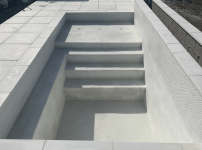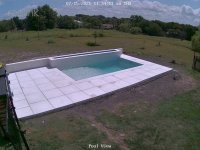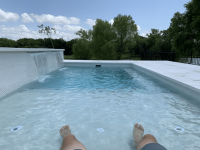Update:
All equipment was received and installed this past week! Woohoo!
Installation took around 4 hours. Partly because I wanted the feeders to be plugged directly in to GFCI outlets in a weather proof box so the tech had to run flex conduit from the Omni 15ft to the feeders. After the hardware was installed there was some software configuration within the Omnilogic required to activate the Sense and Dispense system. Both ORP and PH probes worked out of box which is always a nice thing. After calibrating using the pinpoint 7.0 solution, I did find it was reading .1 higher than actual. This was a simple fix as all that is needed is an adjustment in the Omni software.It actually can been done right from the mobile app which was nice. I also confirmed PH with my taylor kit as well as with my local Leslie Pool store who uses the Lamotte Digital tester. I know, I know, Leslie is the Devil, but I gotta say my local Leslie is pretty good. They don't push ANY product and they know how to execute the Lamotte tests consistently. Basically I go to them to take advantage of a $1,000 test device,

For the first day I put the system in test only mode which basically allows me to view PH and ORP readings without dispensing. This allowed me to build up some confidence in the accuracy of the readings. Then I enabled PH and set it to 7.7. I immediately saw the impact PH had on ORP. As my ph decreased, my ORP readings increased. The below readings confirm it.
Initial readings
ORP 530mV
PH 7.9
FC 2.8
60 minutes later after adding Muriatic acid to get Ph to 7.7(recalibrated the probe after dosing. so even though It was set to 7.7 it was actually 7.6)
ORP 750mV
PH 7.6
FC 2.8
The feeders are now both filled with the appropriate chemicals. 10% HDX Liquid Chlorine(12 gallons) in one and 3 parts water(11 gallons)/1 part HDX Muriatic acid(3 1/2 gallons) in the other. So far it has only dipped below 7.7 twice and both times the stenner pumps would turn on for about 30 seconds then turn off for what seemed like 5 mins, then repeated until reaching 7.7.
Now with PH stable, I have activated ORP and set to 700mV. It has not dipped below 700 yet so I'm eagerly awaiting., I will be testing FC every day using my taylor kit to see how FC levels impact my ORP readings. I also have an Ozonator which can also impact ORP readings. I think one of the biggest questions has always been how do you know if your ozonator is working? It looks like ORP can possible give you some insights in to that. I may even turn the Ozonator off at some point to see if and how much my Orp level decreases.
Since the weather is cold I'm not too worried about my FC level. In fact this is probably the best time to introduce a system like this since there is some room for error. Eventually I'd like to match up the right ORP level to the level of FC recommended by TFP. I Suspect I'll need to raise ORP to >750mV to accomplish this.
I also made one additional adjustment to disable chemical dispensing while the SPA is running. This was also an easy configuration change within the mobile app.
So far I'm pleased with the results. It's still early so I plan to provide updates regularly on the performance of this system. Although I don't expect I will be manually adding chemicals daily like I have been in the past, I do expect more work monitoring and maintaining the system ie.. periodic Probe cleaning, Feeder refilling, Stenner Pump Maintenance are all required to keep this working. This is NOT a set and forget system!
Pic of HL-CHEM unit installed. The device attaches directly to the side of the Omnilogic case. No anchors in brick required.
View attachment 173083
Chemical Feeders Plugged in to electrical box. The blue tubing that feeds the chemicals then connects right before the water returns to pool
View attachment 173084
View of the PH and ORP from the home screen of my Hayward Mobile app
View attachment 173085
PH Calibration screen in the Mobile app. You can see I changed the offset by -1 to correct the reading.
View attachment 173086
Pic of the dispensing units set to Off when in SPA mode.
View attachment 173087




